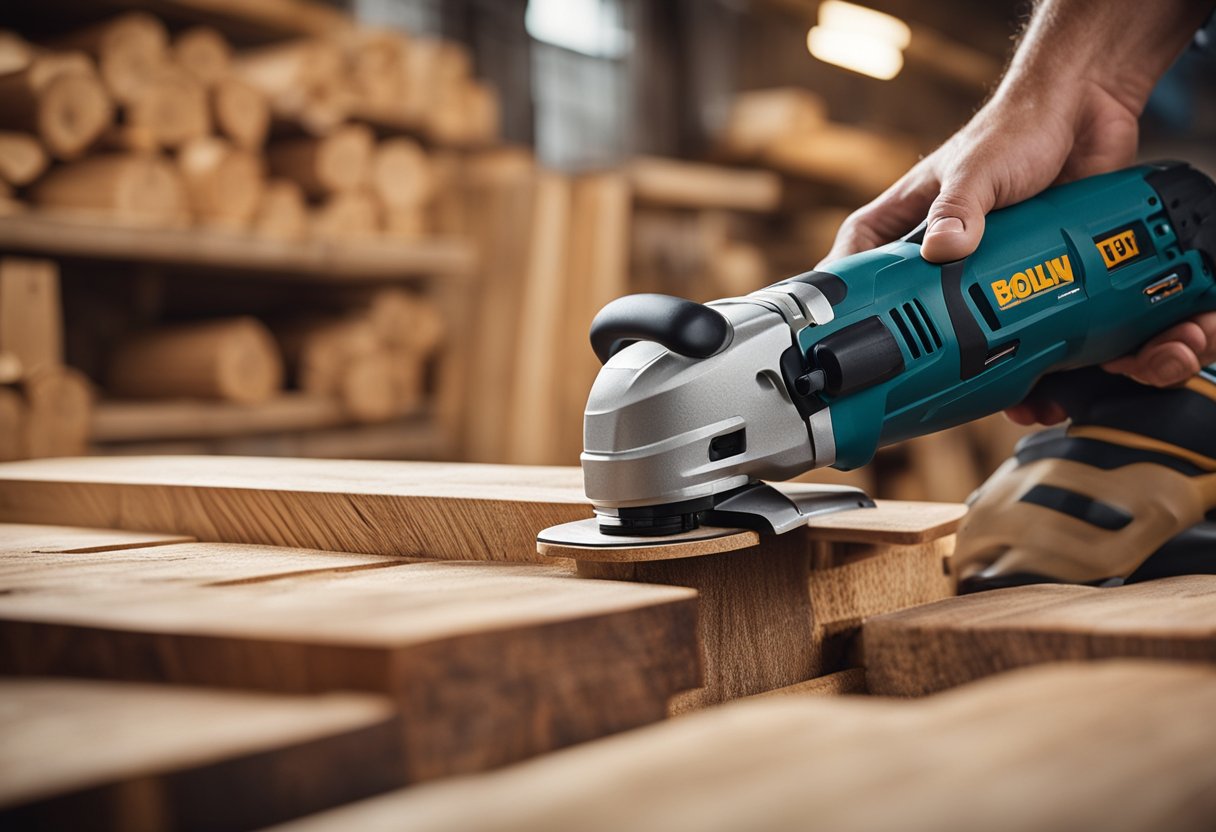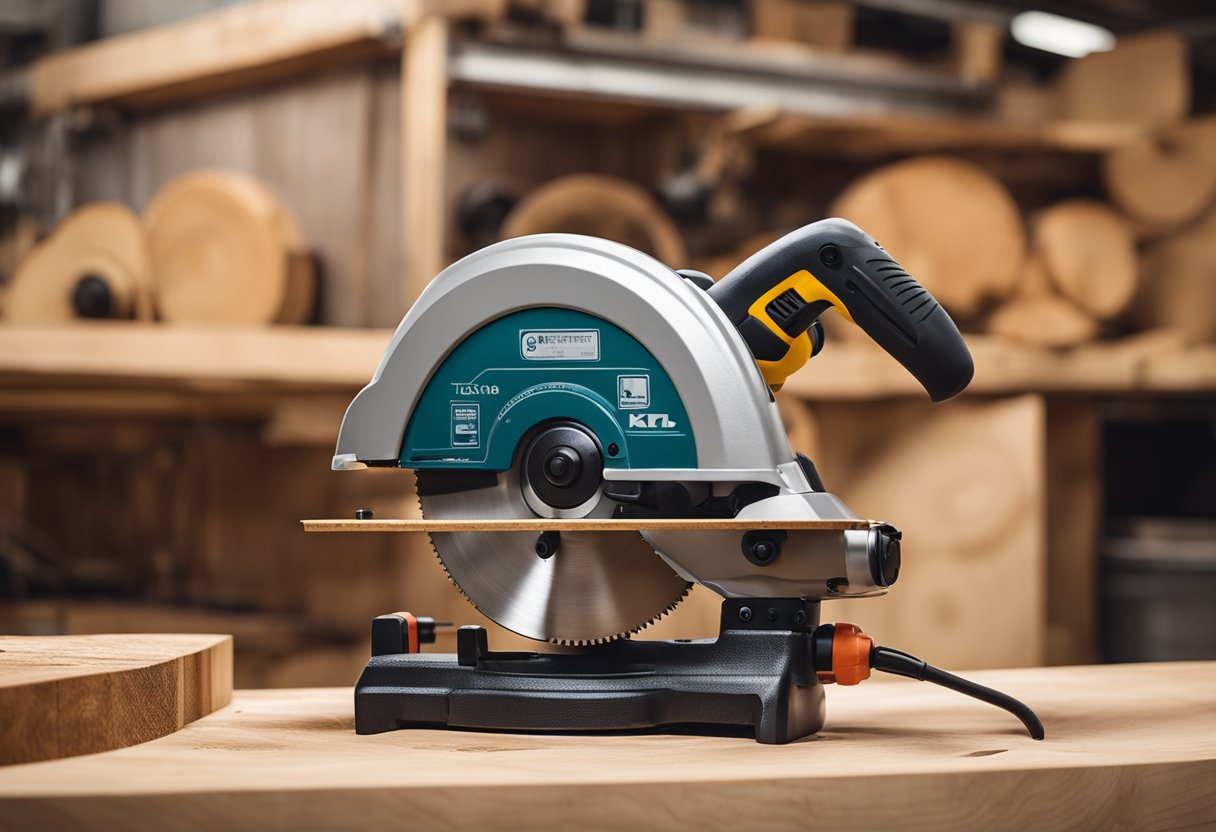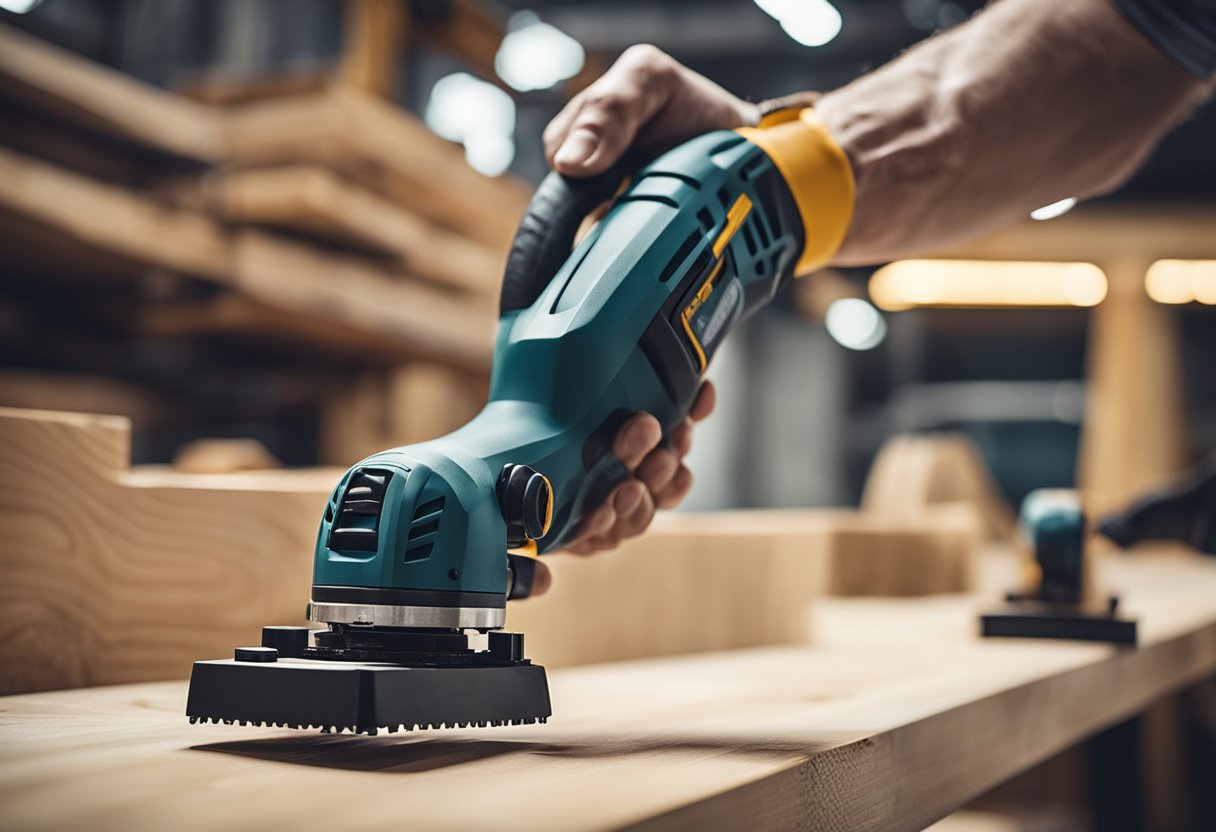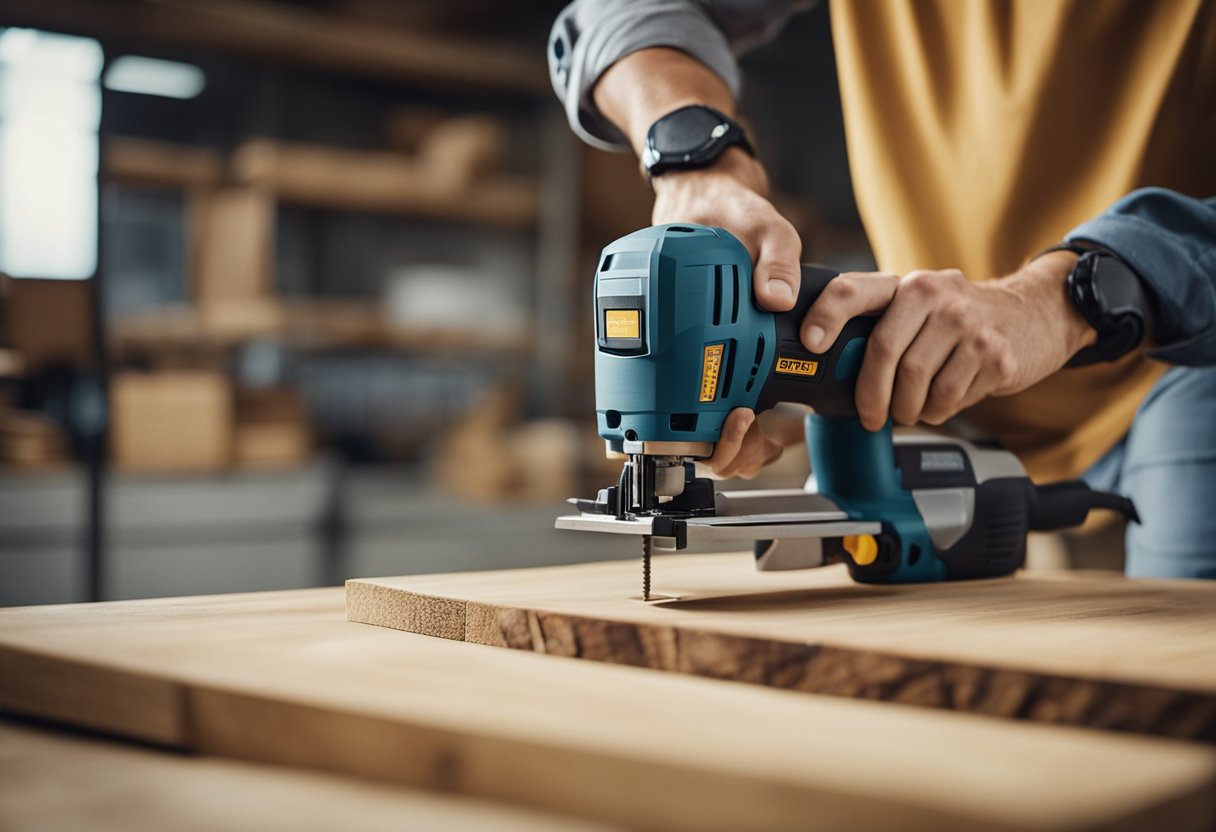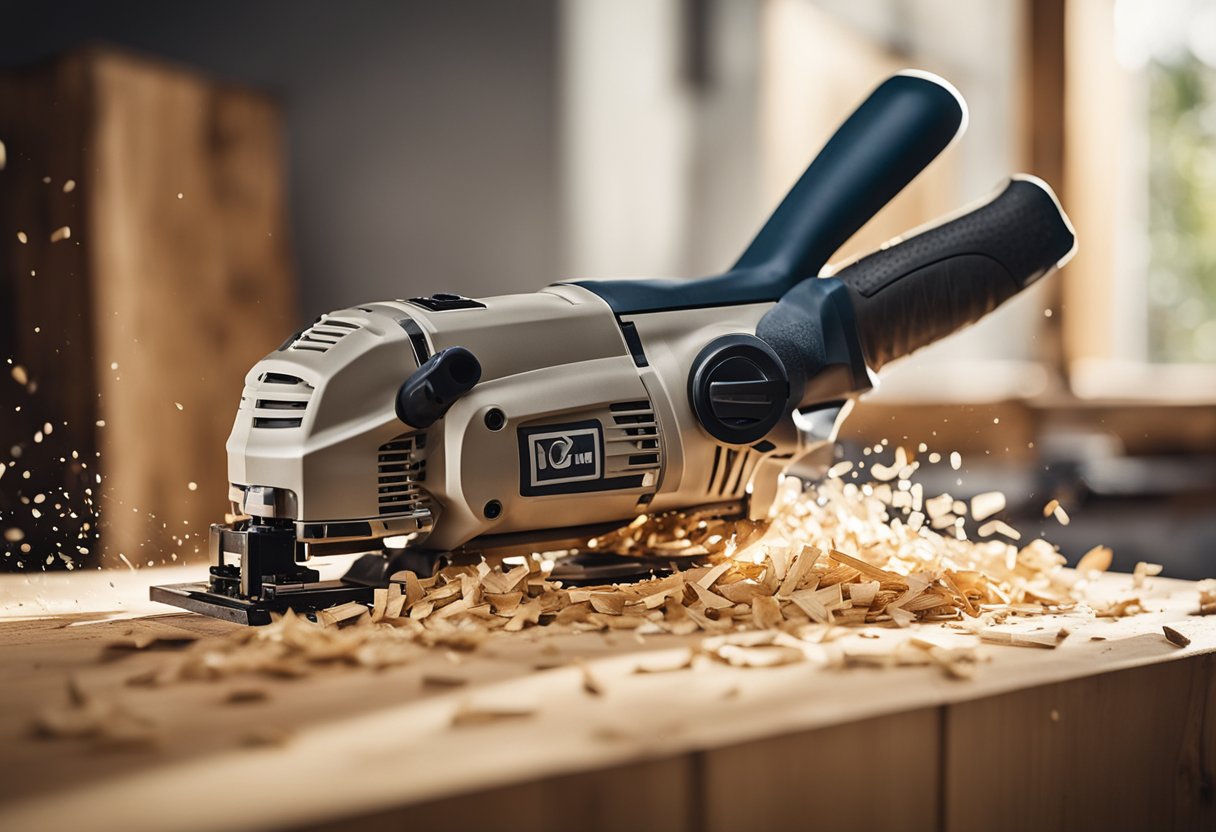Can an oscillating tool cut wood? This is a common question among DIY enthusiasts and professionals alike. Oscillating tools are versatile and can be used for various applications, but can they really cut through wood? The short answer is yes, oscillating tools can cut wood, and they are actually quite efficient at it.
Oscillating tools are designed to make precise cuts, and they are perfect for cutting wood in tight spaces where other tools cannot reach. They are also ideal for cutting small pieces of wood, trimming door jambs, and making precision cuts on baseboards and other types of molding. However, it’s important to choose the right blade for the job to get the best results.
Key Takeaways:
- Oscillating tools can cut wood efficiently and precisely, making them ideal for various applications.
- Choosing the right blade for the job is crucial to get the best results when cutting wood with an oscillating tool.
- Oscillating tools are versatile and can be used for cutting different materials, but it’s important to follow safety and maintenance tips to ensure their longevity.
Understanding Oscillating Tools
https://www.youtube.com/watch?v=RZcXy6-llXs&embed=true
An oscillating tool, also known as an oscillating saw or multi-tool, is a handheld power tool that can be used for a variety of different tasks. The tool works by oscillating back and forth at a high speed, allowing it to make precise cuts in a variety of materials, including wood, metal, and plastic.
Oscillating tools come in both corded and cordless varieties, giving users the flexibility to choose the option that works best for their needs. Cordless oscillating tools are powered by rechargeable batteries, making them ideal for use in areas where access to an electrical outlet may be limited.
In addition to the tool itself, there are a variety of attachments and accessories available for oscillating tools. These attachments can be used to perform a wide range of tasks, including sanding, grinding, and even polishing.
When it comes to cutting wood, an oscillating tool is a versatile and effective option. The tool’s oscillating action allows for consistent and accurate cuts, while its adaptability to different woodcutting tasks is enhanced by the various attachments and accessories available.
Overall, an oscillating tool is a valuable addition to any DIY enthusiast’s toolbox. Its versatility and precision make it a reliable option for a wide range of tasks, including cutting wood.
Key Functions of Oscillating Tools
https://www.youtube.com/watch?v=prW2QdElZzg&embed=true
As someone who has used oscillating tools for various DIY projects, I can confidently say that these tools are versatile and can perform a wide range of functions. Here are some of the key functions of oscillating tools:
Cutting
Oscillating tools are great for cutting through different materials such as wood, metal, and plastic. They can make precise cuts and are ideal for cutting in tight spaces where other tools may not fit.
Plunge Cutting
One of the unique functions of oscillating tools is their ability to make plunge cuts. This means that you can start cutting in the middle of a piece of material, without having to make a hole or notch first. This is especially useful when you need to make a precise cut in the middle of a piece of wood or metal.
Sanding
Oscillating tools are also great for sanding. They come with sanding pads that can be used to sand wood, metal, and other materials. The sanding pads come in different grits, so you can choose the right one for the job.
Scraping
If you need to remove paint, glue, or other materials from a surface, an oscillating tool with a scraping attachment can make the job easier. The scraping attachment can be used to remove materials from flat surfaces as well as corners and edges.
Sawing
Oscillating tools can also be used for sawing. They can make straight cuts as well as flush cuts, which means you can cut a piece of material flush to another surface. This is useful when you need to trim a piece of wood or metal to fit in a specific space.
Grout Removal
If you need to remove grout from between tiles, an oscillating tool with a grout removal attachment can make the job easier. The grout removal attachment can be used to remove grout without damaging the tiles.
Polishing
Oscillating tools can also be used for polishing. They come with polishing pads that can be used to polish metal, plastic, and other materials. The polishing pads come in different grits, so you can choose the right one for the job.
Trimming
Oscillating tools can be used for trimming wood and other materials. They can make precise cuts and are ideal for trimming small pieces of material.
Notching
If you need to make a notch in a piece of material, an oscillating tool can make the job easier. You can use the oscillating tool to make a precise notch without damaging the rest of the material.
Straightedge
If you need to make a straight cut, you can use a straightedge with your oscillating tool. The straightedge will help guide the blade and ensure that you make a straight cut.
Toolbox
Oscillating tools are a great addition to any toolbox. They are versatile and can perform a wide range of functions, making them ideal for DIY projects and home repairs.
Choosing the Right Blade
https://www.youtube.com/watch?v=PPJhjSITLnk&embed=true
As I mentioned earlier, an oscillating tool can cut wood, but choosing the right blade is crucial to get the job done correctly. There are different types of blades available in the market, and each one has its own unique features that make it suitable for specific applications. Here are some of the most common types of blades that you can use to cut wood with an oscillating tool:
Bi-Metal Blade
A bi-metal blade is a versatile blade that can cut through different materials, including wood, metal, and plastic. It is made of two different metals, which gives it the ability to withstand high-speed cutting and prevents it from overheating. The blade has sharp teeth that can cut through wood quickly and efficiently.
Carbide Blade
A carbide blade is a durable blade that is ideal for cutting through hardwoods and other tough materials. It has teeth that are coated with carbide, which makes them more durable and resistant to wear and tear. This type of blade is perfect for cutting through thick pieces of wood or making precise cuts.
Plunge Cut Blade
A plunge cut blade is a specialized blade that is designed to make plunge cuts into wood. It has a pointed tip that allows you to start the cut in the middle of the wood without having to make a pilot hole first. This type of blade is perfect for making cutouts in wood or cutting holes for electrical outlets.
Flush-Cutting Blade
A flush-cutting blade is a blade that is designed to cut flush with the surface of the wood. It has a flat profile that allows you to cut close to the surface without damaging it. This type of blade is perfect for trimming door jambs or cutting off protruding nails.
Diamond Blade
A diamond blade is a blade that is coated with diamond particles, which makes it ideal for cutting through hard materials like stone, tile, and concrete. While it is not specifically designed for cutting wood, it can be used to cut through hardwoods and other tough materials.
In summary, choosing the right blade for your oscillating tool is crucial to getting the job done correctly. Bi-metal blades, carbide blades, plunge cut blades, flush-cutting blades, and diamond blades are all excellent options for cutting wood with an oscillating tool. It is essential to consider the type of wood you are cutting, the thickness of the wood, and the type of cut you need to make when choosing the right blade.
Cutting Different Materials
https://www.youtube.com/watch?v=HxFSfnXfYL0&embed=true
As an oscillating tool user, I can attest that this tool is versatile and flexible when it comes to cutting different materials. It can cut through a range of materials including wood, metal, tile, drywall, grout, door, pipe, plastic, mortar, concrete, sheet metal, glass, PVC, laminate, plywood, hardwood, cement, ceramic tile, plaster, stone, and fiberglass.
When it comes to cutting wood, an oscillating tool may not be the first tool to come to mind. However, it can be used for many types of cuts, such as making plunge cuts, flush cuts, and even curved cuts. To cut wood, you will need an oscillating tool, a cutting blade, and a piece of wood. The type of blade you use depends on the type of cut you want to make. For example, a wood blade is ideal for cutting through wood, while a metal blade is best for cutting through metal.
An oscillating tool can also be used to cut through sheet metal and metals. A metal cutting blade is necessary for cutting through metals. When cutting through metals, it is important to use a slow and steady approach to avoid overheating the blade.
The tool can also be used for cutting through plastic, PVC, and laminate. A flush cut blade is ideal for cutting through these materials. When cutting through plastic, it is important to use a slow and steady approach to avoid melting the material.
In addition to the materials mentioned above, an oscillating tool can also be used for cutting through ceramic tile, plaster, and stone. A diamond blade is necessary for cutting through these hard materials. When cutting through ceramic tile, it is important to use water to cool the blade and avoid cracking the tile.
Overall, an oscillating tool is a versatile tool that can be used for cutting through a wide range of materials.
Specific Applications of Oscillating Tools
https://www.youtube.com/watch?v=7RPJaSxMcoM&embed=true
As a versatile power tool, oscillating tools can be used for various tasks such as sanding, cutting, grinding, and scraping. Here are some specific applications of oscillating tools that can help you get the job done:
Cutting Wood
Oscillating tools are great for cutting wood, especially for small DIY projects. With the right blade, you can make plunge cuts, flush cuts, and even curved cuts. It is important to choose the right blade for the job, as different blades are designed for different materials. For example, a wood blade has larger teeth and is designed for cutting through wood, while a metal blade has smaller teeth and is designed for cutting through metal.
Removing Old Flooring
When it comes to removing old flooring, oscillating tools can be a lifesaver. They can easily cut through adhesive and other materials, making it easier to remove old flooring. You can also use an oscillating tool to cut through nails and other fasteners that are holding the flooring in place.
Cutting Cabinet and Baseboard Trim
Oscillating tools are perfect for cutting cabinet and baseboard trim. They can make precise cuts and are great for cutting in tight spaces. You can also use an oscillating tool to cut through nails and other fasteners that are holding the trim in place.
Removing Caulk and Paint
If you need to remove caulk or paint, an oscillating tool can make the job much easier. You can use a scraper blade to remove caulk and a sanding pad to remove paint. Oscillating tools are also great for sanding and smoothing surfaces.
Cutting Pipes and Doorjambs
Oscillating tools are great for cutting pipes and doorjambs. They can make precise cuts and are great for cutting in tight spaces. You can also use an oscillating tool to cut through nails and other fasteners that are holding the pipes or doorjambs in place.
Removing Mold
If you need to remove mold, an oscillating tool can make the job much easier. You can use a scraper blade to remove the mold and a sanding pad to smooth the surface. Oscillating tools are also great for sanding and smoothing surfaces.
Cutting Metal
Oscillating tools can also be used for cutting metal. With the right blade, you can make precise cuts in metal. It is important to choose the right blade for the job, as different blades are designed for different materials. For example, a metal blade has smaller teeth and is designed for cutting through metal.
Furniture and Flooring Prep
Oscillating tools are great for preparing furniture and flooring for refinishing. You can use a sanding pad to remove old finishes and smooth surfaces. Oscillating tools are also great for sanding and smoothing surfaces.
Trim Shims
Oscillating tools are great for cutting trim shims. They can make precise cuts and are great for cutting in tight spaces. You can also use an oscillating tool to cut through nails and other fasteners that are holding the trim shims in place.
Safety and Maintenance Tips
When using an oscillating tool to cut wood, safety should always be a top priority. Here are some tips to ensure that you are using your oscillating tool safely:
- Always wear eye protection and a dust mask to protect yourself from flying debris and sawdust.
- Make sure that your workpiece is securely clamped down to prevent it from moving around while you are cutting.
- Keep your fingers and hands away from the blade at all times. Oscillating tool blades have sharp teeth that can cause serious injury if you accidentally touch them.
- Avoid overheating the blade by allowing it to cool down periodically during use. Overheating can cause the blade to warp or even break, which can be dangerous.
- Use the correct size and type of blade for the job. Using the wrong blade can cause the tool to overheat or the blade to break.
- Keep your oscillating tool clean and well-maintained. Regularly inspect the blade for damage or wear and replace it as needed.
By following these safety and maintenance tips, you can ensure that you are using your oscillating tool safely and effectively.
Top Oscillating Tool Brands
When it comes to oscillating tools, there are a few brands that stand out from the rest. In my experience, Bosch and Fein are two of the top brands to consider.
Bosch is known for producing high-quality tools that are both durable and reliable. Their oscillating tools are no exception. With a wide range of accessories available, you can use a Bosch oscillating tool for a variety of tasks, including cutting wood.
Fein is another top brand when it comes to oscillating tools. They are known for their innovative technology, which allows for faster and more efficient cutting. Their tools are also known for their durability, making them a great choice for professionals who need a tool that can handle heavy use.
Both Bosch and Fein offer a range of oscillating tools to choose from, so you can find one that fits your needs and budget. Whether you’re a DIY enthusiast or a professional contractor, these brands have something to offer.
When choosing an oscillating tool, it’s important to consider factors such as power, speed, and versatility. Both Bosch and Fein offer tools that excel in these areas, making them great choices for anyone in need of a reliable oscillating tool.
In summary, Bosch and Fein are two of the top brands to consider when looking for an oscillating tool that can cut wood. With their reputation for quality and innovation, you can’t go wrong with either of these brands.
Buying Oscillating Tools Online
When it comes to buying oscillating tools online, there are a few things to consider to ensure that you get the best tool for your needs. Here are some tips to help you make an informed decision:
1. Read Reviews
Before making a purchase, it’s important to read reviews from other customers who have used the product. This will give you an idea of the tool’s performance, durability, and overall value. Look for reviews on the website where you plan to make your purchase, as well as on other websites that specialize in tool reviews.
2. Check the Comfort Level
Using an oscillating tool for extended periods can be tiring, so it’s important to choose a tool that is comfortable to hold and use. Look for a tool with an ergonomic design that fits comfortably in your hand. Some models also come with vibration-reducing technology to make the tool more comfortable to use.
3. Look for Deals
Shopping online can be a great way to find deals on oscillating tools. Look for sales, discounts, and other promotions that can help you save money on your purchase. Some websites also offer free shipping or other incentives to encourage customers to buy.
4. Check the Warranty
Before making a purchase, be sure to check the warranty that comes with the tool. A good warranty can give you peace of mind and protect you against defects or other issues that may arise. Look for a warranty that covers both parts and labor, and be sure to read the fine print to understand what is and isn’t covered.
By following these tips, you can find the right oscillating tool for your needs and ensure that you get the best value for your money.
Frequently Asked Questions
Can an oscillating tool be used to cut wood?
Yes, an oscillating tool can be used to cut wood. In fact, it is a versatile tool that can be used for a variety of tasks, including cutting wood. However, it is important to note that an oscillating tool is not the ideal tool for every wood-cutting job. It is best suited for small wood projects.
What type of blade is best for cutting wood with an oscillating tool?
The best type of blade for cutting wood with an oscillating tool is a bi-metal blade with coarse teeth. This type of blade is designed to cut through wood quickly and efficiently. It is important to choose the right blade for the job to ensure clean and precise cuts.
Is it safe to use an oscillating tool to cut wood?
Yes, it is safe to use an oscillating tool to cut wood as long as you follow proper safety precautions. Make sure to wear safety goggles and gloves to protect your eyes and hands. Also, keep your fingers away from the blade and avoid wearing loose clothing that can get caught in the tool.
What is the maximum thickness of wood an oscillating tool can cut?
The maximum thickness of wood an oscillating tool can cut depends on the power and size of the tool. Generally, oscillating tools can cut through wood up to 2 inches thick. However, it is important to note that thicker wood may require multiple passes to cut through.
Can an oscillating tool cut through hardwood?
Yes, an oscillating tool can cut through hardwood. However, it is important to choose the right blade for the job. Hardwood is denser than softwood, so it requires a blade with more teeth and a sharper edge to cut through it.
Are there any tips for cutting a straight line in wood with an oscillating tool?
Yes, there are a few tips for cutting a straight line in wood with an oscillating tool. First, use a straightedge as a guide for the blade. This will help you make a clean and precise cut. Also, make sure to keep the tool level and use a slow and steady motion to avoid any mistakes.

Hi, I’m Sal Muller of Tooltrip.com. My DIY experience led me to understand essential power tools for home projects. Tooltrip.com guides enthusiasts and professionals in choosing right tools for any job. I provide concise top tool reviews for easier, efficient DIY.

